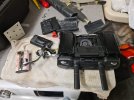More errors. "Industry-standard view is that swelling batteries are a sign of Internal damage that can cause a failure in mid-flight" Exaggerate much? A hypothetically swollen Mini 2 battery would not fit inside the drone. It is not internal damage, but only the mild physical deformation of a Lipo battery that causes any potential electrical disconnection in flight from swelling. Swollen batteries do not fail. They still maintain an electrical charge and perform just as well as an undeformed battery, aside from impact of the physical deformation. When used as supplemental external batteries, swollen LiPo batteries perform just as well as unswollen batteries.
It's one thing to point out that an undocumented feature exists so that the user can prevent auto-discharge from occurring, but falsely claiming it is "the industry-standard view" that it will lead to crashes on the Mini 2 is alarmist hyperbole and fear mongering click bait just to get YT views! There is not a single documented case of any Mini 2 battery ever swelling, and the design of the Mini 2, unlike the Mavic 2, would prevent any hypothetical battery swelling from causing an in flight electrical disconnection. Much ado about nothing!
Every single RC website has the same advice on swollen batteries as did my CAA PfCO and A2CofC training, so from my view, it is an industry-standard view. If you have a different view and know better than practically every RC website and airspace regulatory body, then great.
I'm bored of you constantly claiming I'm full of errors and being alarmist because you have a different opinon; you're actually a rude know-it-all and really, I'm done pushing water up hill with you. Go fly your kite....










